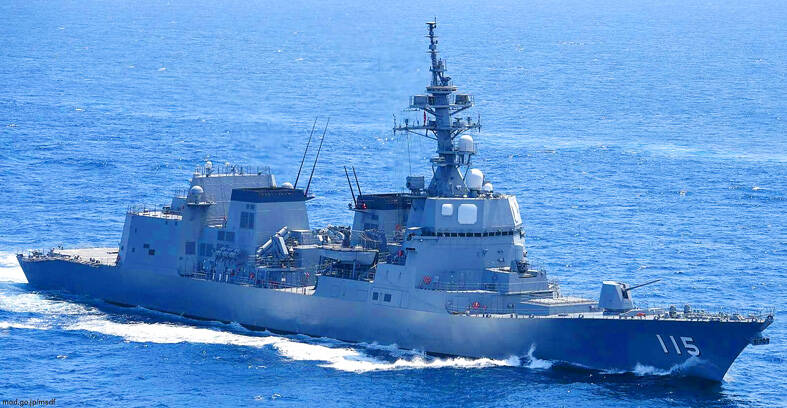An Akizuki-class destroyer last month made the first-ever solo transit of a Japan Maritime Self-Defense Force ship through the Taiwan Strait, Japanese government officials with knowledge of the matter said yesterday.
The JS Akizuki carried out a north-to-south transit through the Taiwan Strait on Feb. 5 as it sailed to the South China Sea to participate in a joint exercise with US, Australian and Philippine forces that day.
The Japanese destroyer JS Sazanami in September last year made the Japan Maritime Self-Defense Force’s first-ever transit through the Taiwan Strait, but it was joined by vessels from New Zealand and Australia, the Japanese daily Sankei Shimbun reported.

Photo: Screen grab from Seaforces.org’s Web site
The Akizuki-class destroyer made last month’s transit alone, and the move aimed to counter China’s aggressive behavior in the East and South China seas, the Sankei Shimbun reported.
The Japan Maritime Self-Defense Force in a news release on Feb. 6 said that the JS Akizuki conducted a Japan-US-Australia-Philippine multilateral exercise in the South China Sea.
“Upholding the right of freedom of navigation and overflight, other lawful uses of the sea and international airspace, as well as respect for maritime right under international law, as reflected in the UN Convention on the Law of the Sea, the maritime cooperative activity showed a commonsense of value and a strong will to realize a ‘Free and Open Indo-Pacific,’” it said.
Japanese Prime Minister Shigeru Ishiba approved the destroyer’s transit in response to previous proactive actions by China, a source with knowledge of the matter was quoted as saying in the report.
Six Chinese ships, including three military vessels and three coast guard vessels, sailed from the Pacific Ocean to the East China Sea in December last year, they were also quoted as saying.
Four China Coast Guard vessels have also been making intrusions into the territorial waters of the Diaoyutais (釣魚台列嶼), known as the Senkaku Islands in Japan, which are administered by Japan, but also claimed by Taiwan and China. Tokyo sees the vessels’ actions as provocative, they said.
The Taiwan Strait is considered to be international waters by many countries including the US.
The Japan Maritime Self-Defense Force said that freedom of navigation should be ensured, but with concerns over China’s strong opposition, Japan previously did not send ships to transit the Taiwan Strait, the Sankei Shimbun reported.
However, as cross-strait tensions have been rising, Japan’s stance has also changed and is now proactively calling for freedom of navigation in the Taiwan Strait, it said.

Conflict with Taiwan could leave China with “massive economic disruption, catastrophic military losses, significant social unrest, and devastating sanctions,” a US think tank said in a report released on Monday. The German Marshall Fund released a report titled If China Attacks Taiwan: The Consequences for China of “Minor Conflict” and “Major War” Scenarios. The report details the “massive” economic, military, social and international costs to China in the event of a minor conflict or major war with Taiwan, estimating that the Chinese People’s Liberation Army (PLA) could sustain losses of more than half of its active-duty ground forces, including 100,000 troops. Understanding Chinese

The Ministry of Foreign Affairs (MOFA) yesterday said it is closely monitoring developments in Venezuela, and would continue to cooperate with democratic allies and work together for regional and global security, stability, and prosperity. The remarks came after the US on Saturday launched a series of airstrikes in Venezuela and kidnapped Venezuelan President Nicolas Maduro, who was later flown to New York along with his wife. The pair face US charges related to drug trafficking and alleged cooperation with gangs designated as terrorist organizations. Maduro has denied the allegations. The ministry said that it is closely monitoring the political and economic situation

UNRELENTING: China attempted cyberattacks on Taiwan’s critical infrastructure 2.63 million times per day last year, up from 1.23 million in 2023, the NSB said China’s cyberarmy has long engaged in cyberattacks against Taiwan’s critical infrastructure, employing diverse and evolving tactics, the National Security Bureau (NSB) said yesterday, adding that cyberattacks on critical energy infrastructure last year increased 10-fold compared with the previous year. The NSB yesterday released a report titled Analysis on China’s Cyber Threats to Taiwan’s Critical Infrastructure in 2025, outlining the number of cyberattacks, major tactics and hacker groups. Taiwan’s national intelligence community identified a large number of cybersecurity incidents last year, the bureau said in a statement. China’s cyberarmy last year launched an average of 2.63 million intrusion attempts per day targeting Taiwan’s critical

AGING: As of last month, people aged 65 or older accounted for 20.06 percent of the total population and the number of couples who got married fell by 18,685 from 2024 Taiwan has surpassed South Korea as the country least willing to have children, with an annual crude birthrate of 4.62 per 1,000 people, Ministry of the Interior data showed yesterday. The nation was previously ranked the second-lowest country in terms of total fertility rate, or the average number of children a woman has in her lifetime. However, South Korea’s fertility rate began to recover from 2023, with total fertility rate rising from 0.72 and estimated to reach 0.82 to 0.85 by last year, and the crude birthrate projected at 6.7 per 1,000 people. Japan’s crude birthrate was projected to fall below six,